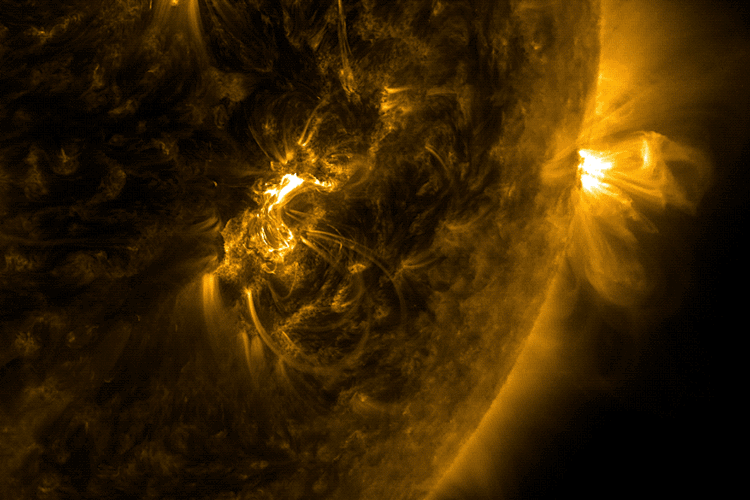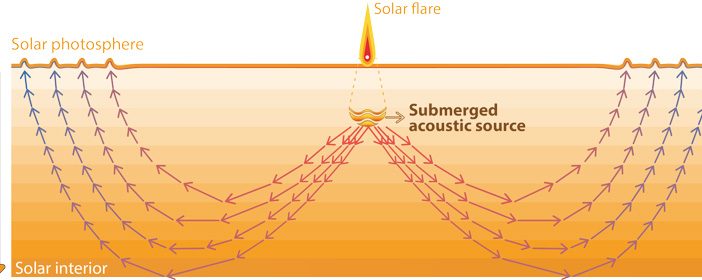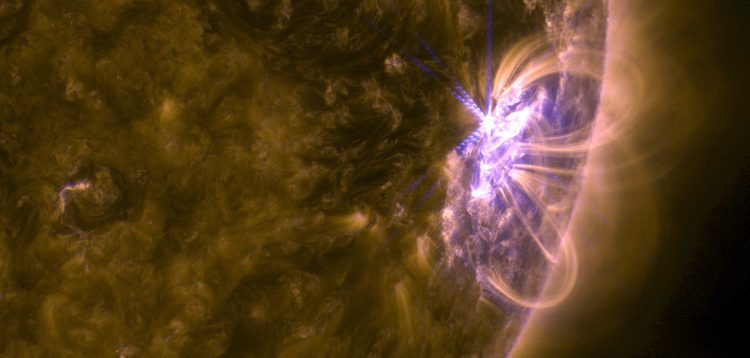Solar flares are violent explosions on the sun that fling out high-energy charged particles, sometimes toward Earth, where they disrupt communications and endanger satellites and astronauts. These flares can also create seismic activity — sunquakes — releasing impulsive acoustic waves that penetrate deep into the sun’s interior.
While the relationship between solar flares and sunquakes is still a mystery, new findings suggest that these “acoustic transients” — and the surface ripples they generate — can tell us a lot about flares and may someday help us forecast their size and severity.
According to a report by University of California, Berkley, a team of physicists from the USA, Colombia and Australia has found that part of the acoustic energy released from a flare in 2011 emanated from about 1,000km beneath the solar surface — the photosphere — and, thus, far beneath the solar flare that triggered the quake, with the findings detailed in a recent paper published in The Astrophysical Journal Letters.
The results come from a diagnostic technique called helioseismic holography, introduced in the late 1900s by French scientist Françoise Roddier and extensively developed by US scientists Charles Lindsey and Douglas Braun, now at NorthWest Research Associates in Boulder, Colorado, and co-authors of the paper.
Helioseismic holography enables scientists to analyze acoustic waves triggered by flares to probe their sources. “It‘s the first helioseismic diagnostic specifically designed to directly discriminate the depths of the sources it reconstructs, as well as their horizontal locations,” Braun said.
“We can’t see the sun’s inside directly. It is opaque to the photons that show us the sun’s outer atmosphere, from where they can escape to reach our telescopes,” said co-author Juan Camilo Buitrago-Casas, a University of California, Berkeley, doctoral student in physics from Colombia. “The way we can know what happens inside of the sun is via seismic waves that make ripples on the solar surface similar to those caused by earthquakes on our planet. We are reporting the deepest source of acoustic waves so far known in the sun.”
 The acoustic explosions that cause sunquakes in some flares radiate acoustic waves in all directions, primarily downward, ultimately heading back up to the surface due to refraction, where they create ripples. “The ripples, then, are not just a surface phenomenon, but the surface signature of waves that have gone deep beneath the active region and then back up to the outlying surface in the succeeding hour,” Lindsey explained. Analyzing the surface ripples can pinpoint the source of the explosion.
The acoustic explosions that cause sunquakes in some flares radiate acoustic waves in all directions, primarily downward, ultimately heading back up to the surface due to refraction, where they create ripples. “The ripples, then, are not just a surface phenomenon, but the surface signature of waves that have gone deep beneath the active region and then back up to the outlying surface in the succeeding hour,” Lindsey explained. Analyzing the surface ripples can pinpoint the source of the explosion.
“It has been widely supposed that the waves released by acoustically active flares are injected into the solar interior from above. What we are finding is the strong indication that some of the source is far beneath the photosphere,” observed Juan Carlos Martínez Oliveros, a solar physics researcher at UC Berkeley’s Space Sciences Laboratory and a native of Colombia, involved in the paper.
“We have only recently discovered that some of those sources are submerged below the solar surface,” remarked Lindsey. “This may help explain a great mystery: Some of these acoustic waves have emanated from locations that are devoid of local surface disturbances that we can directly see in electromagnetic radiation. We have wondered for a long time how this can happen.”
The sun’s seismic activity can be detected by the Doppler shift of light emanating from the surface, and is understood to be driven by convective storms that form a patchwork of granules about the size of Texas, covering the sun’s surface and continually rumbling. As more sunquakes have been discovered, flare seismology has blossomed, as have the techniques to explore their mechanics and their possible relationship to the architecture of magnetic flux underlying active regions.
Until now, most solar flares have been studied as one-offs, since strong flares, even during times of maximum solar activity, may occur only a few times a year. The initial focus was on the largest, or X-class, flares, classified by the intensity of the soft x-rays they emit. Buitrago-Casas, who obtained his bachelor’s and master’s degrees from Universidad Nacional de Colombia, teamed up with Lindsey and Martínez Oliveros to conduct a systematic survey of relatively weak solar flares to increase their database, for a better understanding of the mechanics of sunquakes.
Of the 75 flares captured between 2010 and 2015 by the RHESSI satellite — a NASA x-ray satellite designed, built and operated by the Space Sciences Laboratory and retired in 2018 — 18 produced sunquakes. One of Buitrago-Casas’s acoustic transients, the one released by the flare of July 30, 2011, caught the eyes of undergraduate students Martínez, now a graduate student, and Quintero Ortega.
 “We gave our student collaborators at the National University the list of flares from our survey. They were the first ones who said, ‘Look at this one. It’s different! What happened here?’” Buitrago-Casas noted. “And so, we found out. It was super exciting!”
“We gave our student collaborators at the National University the list of flares from our survey. They were the first ones who said, ‘Look at this one. It’s different! What happened here?’” Buitrago-Casas noted. “And so, we found out. It was super exciting!”
Thanks to data from NASA’s Solar Dynamics Observatory satellite, the team was able to pinpoint the source of the explosion that generated the seismic waves 1,000km below the photosphere. This is shallow, relative to the sun’s radius of nearly 700,000km, but deeper than any previously known acoustic source in the sun. A source submerged below the sun’s photosphere, with its own morphology and no conspicuous directly overlying disturbance in the outer atmosphere, suggests that the mechanism that drives the acoustic transient is itself submerged.
About half of the medium-sized solar flares that Buitrago-Casas and Martínez Oliveros cataloged have been associated with sunquakes, showing that they commonly occur together. The team has since found other submerged sources associated with even weaker flares. The discovery of submerged acoustic sources opens the question of whether there are instances of acoustic transients being released spontaneously, with no surface disturbance, or no flare, at all.
“If sunquakes can be generated spontaneously in the sun, this might lead us to a forecasting tool, if the transient can come from magnetic flux that has yet to break the sun’s surface,” Martínez Oliveros said.
“We could then anticipate the inevitable subsequent emergence of that magnetic flux. We may even forecast some details about how large an active region is about to appear and what type — even, possibly, what kinds of flares — it might produce. This is a long shot, but well worth looking into.”



